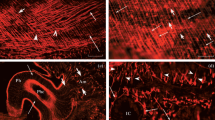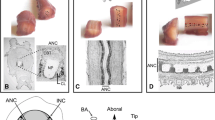Summary
The distribution of serotonin and serotonin-containing neurons was studied in the ganglia of the CNS of the snailLymnaea stagnalis. Results of the application of three different labelling techniques on wholemount preparations were compared with each other and with the serotonin content of the ganglia, measured by high-performance liquid chromatography. Serotonin immunocytochemistry resulted in the highest number of labelled neurons, but the more recently developedin vivo method of 5,6- or 5,7-dihydroxytryptamine-induced pigmentation also proved to be a reliable technique for the visualization of serotonin-containing cell bodies. In comparison with these two techniques, the glyoxylic acid fluorescence method appeared to be less sensitive. The distribution and number of serotonin-containing neurons and biochemically measured serotonin in specific ganglia showed a close correlation. By combining the results of the three labelling techniques, a detailed map of serotonin-containing neurons was constructed, and this was compared with maps of identified neurons prepared from earlier electrophysiological studies. Previously described serotonergic neurons were consistently found, as well as several new serotonin-containirig cell types in the cerebral, visceral and parietal ganglia. A network of serotonin-containing inter- and intraganglionic axon tracts, and thin serotonergic fibres in the perineurium were also demonstrated. Thisin vivo andin vitro identification of serotonin-containing neurons will facilitate further neurophysiological analysis of serotonergic neural mechanisms inLymnaea.
Similar content being viewed by others
References
Audesirk, G. J. (1985) Amine-containing neurons in the brain ofLymnaea stagnalis: Distribution and effects of precursors.Comparative Biochemistry and Physiology 81A, 359–65.
Axelsson, S., Björklund, A., Falck, B., Lindvall, O. &Svensson, L. A. (1973) Glyoxylic acid condensation: A new fluorescence method for the histochemical demonstration of biogenic monoamines.Acta physiologica scandinavica 89, 57–62.
Bailey, C. H., Hawkins, R. D., Chen, M. C. &Kandel, E. R. (1981) Interneurones involved in mediation and modulation of gill-withdrawal reflex inAplysia. IV. Morphological basis of presynaptic facilitation.Journal of Neurophysiology 45, 358–78.
Balaban, P. M., Zakharov, I. S. &Matz, V. N. (1985) Method of vital selective staining of serotonergic nerve cells by 5,7-dihydxroxytryptamine.Dokladi Akademii Nauk SSSR 283, 735–8 (in Russian).
Barber, A. (1982) Monoamine-containing varicosities in the neural sheath of a gastropod mollusc demonstrated by glyoxylic acid histofluorescence.Cell and Tissue Research 226, 267–73.
Benjamin, P. R. (1983) Gastropod feeding: Behavioural and neural analysis of a complex multicomponent system. InNeural Origin of Rhythmic Movements (edited byRoberts, A. &Roberts, B.), pp. 159–93. Cambridge: Cambridge University Press.
Benjamin, P. R. (1984) Interneuronal network acting on snail neurosecretory neurones (Yellow Cells and Yellow-green cells of Lymnaea).Journal of Experimental Biology 113, 165–85.
Benjamin, P. R. &Allison, P. (1985) Regeneration of excitatory, inhibitory and biphasic synaptic connections made by a snail giant interneuron.Proceedings of the Royal Society of London, Series B 226, 159–76.
Benjamin, P. R. &Elliott, C. J. H. (1989) Snail feeding oscillator: The central pattern generator and its control by modulatory interneurones. InCellular and Neuronal Oscillators (edited byJacklet, J.), pp. 173–214. New York: M. Dekker.
Benjamin, P. R., Elliott, C. J. H. &Ferguson, G. P. (1985) Neural network analysis in the snail brain. InModel Neural Networks of Behaviour (edited bySelverston, A.), pp. 87–108. New York: Plenum Press.
Benjamin, P. R. &Rose, R. M. (1979) Central generation of bursting in the feeding system of the snailLymnaea stagnalis.Journal of Experimental Biology 80, 93–118.
Benjamin, P. R., Slade, C. T. &Soffe, S. R. (1980) The morphology of neurosecretory neurones in the pond snail,Lymnaea stagnalis, by the injection of Procion Yellow and horseradish peroxidase.Philosophical Transactions of the Royal Society of London, Series B 290, 449–78.
Benjamin, P. R. &Winlow, W. (1981) The distribution of three wide-acting synaptic inputs to identified neurones in the isolated brain ofLymnaea stagnalis (L.).Comparative Biochemistry and Physiology 70A, 293–307.
Boer, H. H., Schot, L. P. C., Steinbusch, H. W. M., Montagne, C. &Reichelt, D. (1984) Co-existence of immunoreactivity to anti-dopamine, anti-serotonin and anti-vasotocin in the cerebral giant neuron of the pond snailLymnaea stagnalis.Cell and Tissue Research 238, 411–12.
Buckett, K. J. (1987)Neural Peptidergic Modulation of the Snail Heart. PhD Thesis, University of Sussex, Brighton, UK.
Casey, C. &Winlow, W. (1985) Cellular localization of serotonin by glyoxylic acid condensation inLymnaea.Journal of'Physiology 369, 169P.
Cottrell, G. A., Abernethy, K. B. &Barrand, M. A. (1979) Large amine-containing neurons in the central ganglia ofLymnaea stagnalis.Neuroscience 4, 685–9.
De Vlieger, T. A., Devries, C. H. L. &Plesch, B. E. C. (1976) Peripheral and central control of the pneumostome inLymnaea stagnalis. InNeurobiology of Invertebrates. Gastropoda Brain (edited bySalanki, J.), pp. 629–34. Budapest: Akademiai Kiadó.
Elliott, C. J. H. &Benjamin, P. R. (1985) Interactions of pattern-generating interneurones controlling feeding inLymnaea stagnalis.Journal of Neurophysiology 54, 1396–411.
Granzow, B. &Rowell, C. H. F. (1981) Further observations on the serotonergic cerebral neurones ofHelisoma (Mollusca, Gastropoda): The case for homology with the metacerebral giant cells.Journal of Experimental Biology 90, 283–305.
Hernádi, L., Elekes, K. &S.-Rózsa, K. (1989) Distribution of serotonin-containing neurons in the central nervous system of the snailHelix pomatia. Comparison of immunocytochemical and 5,6-dihydroxytryptamine-labelling.Cell and Tissue Research (in press).
Hopkins, W. E., Stone, L. S., Rothman, B. S., Basbaum, A. I. &Mayeri, E. (1982) Egg-laying hormone, Leucine-enkephalin and serotonin-immunoreactivity in the abdominal ganglion ofAplysia: a light microscopic study.Society for Neuroscience Abstracts 8, 587.
Jahan-Parwar, B., S.-Rózsa, K., Salánki, J., Evans, M. L. &Carpenter, D. O. (1987)In vivo labelling of serotonin-containing neurons by 5,7-dihydroxytryptamine inAplysia.Brain Research 426, 173–8.
Joosse, J. (1964) Dorsal bodies and dorsal neurosecretory cells of the cerebral ganglia ofLymnaea stagnalis (L.).Archives Néerlandaises de Zoologie 16, 1–103.
Kemenes, Gy., Benjamin, P. R. &Hiripi, L. (1988) 5,6-dihydroxytryptamine-induced changes in the serotonergic modulation of feeding inLymnaea. InNeurobiology of Invertebrates. Transmitters, Modulators and Receptors (edited bySalánki, J. &S.-Rózsa, K.), pp. 415–31. Budapest: Akadémiai Kiadó.
Kemenes, GY. &S.-Rózsa, K. (1987) The role of serotonergic mechanisms in food-induced arousal of the snailHelix pomatia L. InNeurobiology. Molluscan Models, (edited byBoer, H. H., Geraerts, W. P. M. &Joosse, J.), pp. 277–87. Amsterdam: North-Holland Publishing Company.
Kistler, H. B., Jr, Hawkins, R. D., Koester, J., Steinbusch, H. W. M., Kandel, E. R. &Schwartz, J. H. (1985) Distribution of serotonin-immunoreactive cell bodies and processes in the abdominal ganglion of matureAplysia.Journal of Neuroscience 5, 72–80.
Klemm, N. (1983) Detection of serotonin-containing neurons in the insect nervous system by antibodies to 5-HT. InFunctional Neuroanatomy (edited byStrausfeld, N. J.), pp. 302–16. Berlin: Springer-Verlag.
Land, P. W. &Crow, T. (1985) Serotonin immunoreactivity in the circumesophageal nervous system ofHermissenda crassicornis.Neuroscience Letters 62, 199–205.
McCaman, M. W., Ono, J. K. &McCaman, R. E. (1984) 5-Hydroxytryptamine measurements in molluscan ganglia and neurons using a modified radioenzymatic assay.Journal of Neurochemistry 43, 91–9.
McCrohan, C. R. (1984) Properties of ventral cerebral neurones involved in the feeding system of the snail,Lymnaea stagnalis.Journal of Experimental Biology 108, 257–72.
McCrohan, C. R. &Benjamin, P. R. (1980) Patterns of activity and axonal projections of the cerebral giant cells of the snail,Lymnaea stagnalis.Journal of Experimental Biology 85, 149–68.
McKenzie, J. D., Syed, N. I., Tripp, J. &Winlow, W. (1979) Are pedal cilia inLymnaea under neural control? InNeurobiology. Molluscan Models (edited byBoer, H. H., Geraerts, W. P. M. &Joosse, J.), pp. 26–30. Amsterdam: North Holland Publishing Company.
Nässel, D. R. (1987) Serotonin and serotonin-immunoreactive neurons in the nervous system of insects.Progress in Neurobiology 30, 1–85.
Ono, J. K. &McCaman, R. E. (1984) Immunocytochemical localization and direct assays of serotonin-containing neurons inAplysia.Neuroscience 11, 549–60.
Sakharov, D. A. &Zs-Nagy, I. (1968) Localization of biogenic monoamines in cerebral ganglia ofLymnaea stagnalis L.Acta biologica Academiae Scientiarum hungaricae 19, 145–57.
Saller, C. R. &Salama, A. J. (1984) Rapid automated analysis of biogenic amines and their metabolites using reversed-phase high performance liquid chromatography with electrochemical detection.Journal of Chromatography 309, 287–98.
Salimova, N. B., Sakharov, D. A., Milosević, I., Turpaev, T. M. &Rakić, L. (1987) Monoamine-containing neurons in theAplysia brain.Brain Research 400, 285–99.
Schwartz, J. H. &Shkolnik, L. J. (1981) The giant serotonergic neuron ofAplysia: a multi-targeted nerve cell.Journal of Neuroscience 1, 606–19.
Slade, C. T., Mills, J. &Winlow, W. (1981) The neuronal organisation of the paired pedal ganglia ofLymnaea stagnalis (L.).Comparative Biochemistry and Physiology 69A, 789–803.
S.-Rózsa, K. (1984) The pharmacology of molluscan neurons.Progress in Neurobiology 23, 79–150.
S.-Rózsa, K., Hernádi, L. &Kemenes, Gy. (1986) Selectivein vivo labelling of serotonergic neurones by 5,6-dihydroxytryptamine in the snailHelix pomatia L.Comparative Biochemistry and Physiology 85C, 419–25.
Sternberger, L. A. (1979)Immunocytochemistry, 2nd edn Chichester: John Wiley and Son.
Thomas, J. D., Lough, A. A. &Lodge, R. W. (1975) The chemical ecology ofBiomphalaria glabrata (Say) the snail host ofSchistosoma mansoni (Sambon): the search for factors in media conditioned by snails which inhibit their growth and reproduction.Journal of Applied Ecology 12, 421–34.
Tritt, S. H., Lowe, I. P. &Byrne, J. H. (1983) A modification of the glyoxylic acid induced histofluorescence technique for demonstration of catecholamines and serotonin in tissues ofAplysia californica.Brain Research 259, 159–62.
Vehovszky, A., Kemenes, Gy., Hiripi, L., Hernádi, L. &S.-Rözsa, K. (1988) Reversible effect of 5,6-DHT treatment ofHelix: a combined behavioural, electro-physiological and biochemical study. InNeurobiology of Invertebrates. Transmitters, Modulators and Receptors. (edited bySalánki, J. &S.-Rózsa, K.), pp. 403–14. Budapest: Akadémiai Kiadó.
Walker, R. J. (1986) Transmitters and modulators. InThe Mollusca, Vol. 9,Neurobiology and Behaviour, Part 2 (edited byWillows, A. O. D.), pp. 279–484. New York: Academic Press.
Winlow, W. &Benjamin, P. R. (1976) Neuronal mapping of the brain of the pond snail,Lymnaea stagnalis L. InNeurobiology of Invertebrates. Gastropoda Brain (edited bySalánki, J.), pp. 41–61, Budapest: Akadémiai Kiadó.
Author information
Authors and Affiliations
Rights and permissions
About this article
Cite this article
Kemenes, Elekes, K., Hiripi, L. et al. A comparison of four techniques for mapping the distribution of serotonin and serotonin-containing neurons in fixed and living ganglia of the snail,Lymnaea . J Neurocytol 18, 193–208 (1989). https://doi.org/10.1007/BF01206662
Received:
Revised:
Accepted:
Issue Date:
DOI: https://doi.org/10.1007/BF01206662




